How To Repair Crack In Clay Pot
The Pottery Cycle is supported by its readers. If you click ane of my links, I may earn a committee. I'm too a participant of the Amazon Chapter Program and will brand a commission from qualifying purchases. This helps me keep the website running. Give thanks you lot, I really appreciate your support!
It's disappointing when you work difficult on a piece, merely to have your pottery clay cleft when it is drying. It has happened to me a number of times. And then, I wanted to find a way of eliminating the variables that cause cracking. After some research, this is what I learned…
Pottery dirt cracks when drying if some parts of the slice dry more quickly than others. When clay dries, it shrinks. If one part of the clay is shrinking faster than the other, this puts an internal strain on the pottery. The clay cracks to cope with the strain.
Although the main reason why pottery clay cracks is uneven drying, there are a number of factors involved in this. Read on to find out what else is involved and how to avoid cracks in the time to come.
Why Does Pottery Dirt Crack When Drying?
Uneven Drying is the main reason why clay cracks. It is often said that pottery clay needs to dry slowly to avert bully.
However, the key factor is not then much the speed, but how evenly the dirt dries. The reason information technology's better to let clay dry slowly is that it helps y'all to dry your pottery evenly.
There is a lot of water in dirt. Around 20% of its body weight is h2o. Therefore, as it dries out, it shrinks. Some dirt shrinks more than others. When one office of a slice shrinks more speedily than another, it puts the pottery nether a lot of strain.
Moisture dirt is nonetheless quite malleable, even as information technology is drying out. Every bit a result, it can cope with this kind of strain. Notwithstanding, as the clay dries information technology starts to harden and become more brittle. Therefore, it is less able to manage the different rates at which it is shrinking.
This is why yous are more probable to see pottery dirt crevice at a later point in the drying procedure. So, what causes unevenness in the drying process?
1) Uneven Thickness in Walls Can Make Pottery Dirt Crack
Uneven thickness will make pottery dirt cleft when drying. This is considering thinner parts of your clay volition dry out more speedily than thicker parts.
As clay dries, water migrates from the deeper layers to the surface and evaporates. The further the water has to travel to the surface the longer it takes to dry. Every bit such, thicker sections of your clay will dry out more slowly.
This is why cups and bowls tend to crack on their base when drying. It is partly because the base of the slice is thicker than the sides. Lips of pots and cups tend to dry much more quickly than bases.
2) Circuitous Details and Designs Can Make Pottery Dirt Crack
Pottery with intricate designs is more probable to have some areas that are thinner than others. As such the details volition tend to dry out more quickly than the main body of the piece. The same is true of pottery designs with sharp angles rather than smooth curves.
This is one of the reasons why handles are more at risk of cracking than other parts of your pottery. Handles are exposed to the air at all different angles and water evaporates quickly from them.
three) Larger Pieces of Pottery Clay Crack
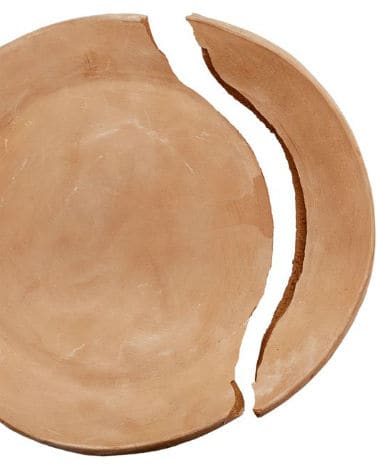
The bigger your pottery the more likely information technology is to fissure as it dries. If your piece is thick, the surface of the ware will dry out out more speedily than the deeper layers.
H2o in the deeper levels of clay has farther to travel and will take longer to leave the clay.
Similarly, large slabs of clay, like large tiles or plates are prone to warp and crack too.
This is because the edges will dry out more than quickly. And considering only 1 big area is exposed to air.
4) Not Wedging Your Dirt (enough!)
An important reason for wedging clay is that it gives the clay an even consistency throughout. This even consistency is called homogeneity.
If clay is not wedged enough, and then some parts of the clay body will be dense and dry. Other parts will exist soft and have a college h2o content.
If you make pottery out of unwedged clay, you are immediately introducing an uneven water content to your piece. This increases the gamble of your pottery clay cracking every bit it dries.
five) Clay Particle Alignment
Clay is made up of tiny particles, that have a long flat shape. In clay that has not been worked, these particles are in a random unorganized design.
When a potter works on a piece of clay, the particles go more than aligned. This is especially the case with bike throwing. The particles on the side of a piece of thrown pottery volition marshal in the same management.
By contrast, dirt particles on the base of the piece tend to stay positioned more randomly.
When clay dries out, the particles shrink more across their brusque width than along their length. If the clay particles on the side of a slice are aligned, it will shrink more than in one direction.
By contrast, the dirt in the base of operations of a piece has non been worked as much equally the sides. As such, they are still organized more randomly. The result of this is that the base tends to shrink less dramatically than the sides.
6) A Low Humidity Atmosphere Can Make Pottery Dirt Crack
Depression humidity levels in the air will cause dirt to dry out more speedily. Humidity tends to be lower in cold climates and seasons. Rapid drying in itself does not make your pottery dirt crack. Nevertheless, it does make information technology harder to dry your greenware out evenly.
Positioning your pottery in a drafty area can too crusade cracking. The parts of your clay that are exposed to the draft volition dry out more quickly.
7) The Blazon of Dirt You Are Using
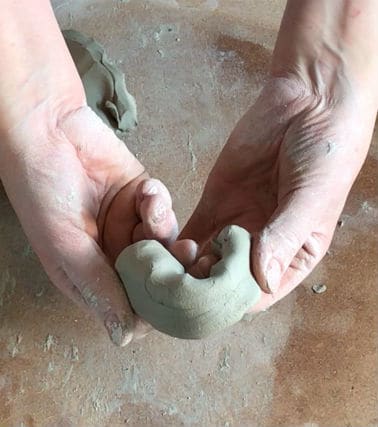
Dirt with high plasticity tends to crevice more on drying. At that place are a couple of reasons for this. Firstly, plastic clay has smaller clay particles.
As such, there is more surface area in the clay for water to adhere to. Also, in that location is proportionally more area in the dirt for h2o between the particles.
Although porcelain dirt is non a plastic dirt torso, it does have a high h2o contentane. As such, information technology is prone to shrink very quickly upon drying. And as a result, it is at more than risk of cracking.
8) Tiny Cracks in Newly Formed Pots
It is sometimes possible to encounter very small-scale cracks in the edges of a piece you have just finished. This is considering, as you work with clay it dries out quite quickly. These tiny cracks create points of vulnerability.
The reason for this is that the tiny cracks begin to dry out more than quickly than the surrounding clay. Tiny cracks tin can then open up up into larger cracks as your ware continues to dry.
How To Stop Your Pottery Clay Not bad:
Here are 11 simple solutions to stop your pottery clay from not bad.
1) Keep Your Dirt at an Even Thickness
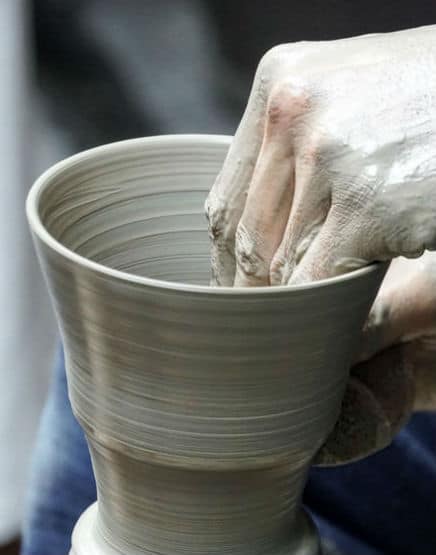
Ensure that the different parts of your pottery are a relatively even thickness. This is particularly the case with bases of cups, bowls, and vases.
You can bank check how thick the base is using a needle tool.
A needle tool is basically a needle with a handle. Press the needle into the base of the pottery until it touches the wheel head. And so slide your finger downward the needle until it touches the clay surface.
Remove the needle and see how far your finger is from the tip of the needle. This will indicate how thick the base of your pottery is.
2) Try to Keep Your Pottery Thinner Overall
It'due south a good idea to try to proceed the walls of your potter thinner. Nonetheless, yous may desire to brand a large piece or something with thicker walls. If yous do, then follow some of the guidelines below about how to dry your pottery out evenly.
3) Cover Your Ware to Prevent Pottery Clay Cracking
Y'all tin can command how apace your pottery dries out past covering it with a plastic pocketbook. The h2o in the clay evaporates and increases the humidity within the bag.
One manner to do this is to brand a plastic tent-similar arrangement over the pottery. If your pottery is sitting on a batt, you lot can trap the edges of the handbag nether the batt to create a seal.
Alternatively, you can leave the base of the pocketbook loose to increase airflow. Whether you lot seal the bag or position it loosely depends upon how humid your environment is. Yous may need to experiment a little.
Annotation that h2o tends to condense on the inside of the plastic purse. In that location is a risk that the bag will touch the surface of the clay. If this happens information technology can make your clay soggy and yous can crusade marks on the surface of your pottery.
If this is likely to happen, it'due south a good idea to cover the pottery with a soft material or paper towels. These will absorb wet from the pocketbook, and stop it from the purse sticking to your pottery.
four) Protecting Areas That Dry out Out Fast
Another way to aid even drying is to cover those parts of the clay that dry more than chop-chop. Wrapping handles and lips with pieces of plastic is recommended. This can bring the rate at which they dry in line with the residuum of your pottery.
You lot can also use wax resist to achieve a similar result. Wax resist is a waxy emulsion that can be applied to handles and lips to slow moisture loss.
If applying wax resist to a handle, remember to go out a thin strip on the handle free of wax. This gives the moisture somewhere to escape from.
5) Using a Clammy Box To Stop Your Pottery Clay Dandy
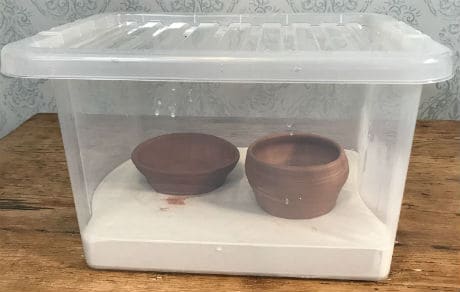
Another style to cover your pottery is by using a damp box. You can make a damp box easily past setting a 1-2 inch layer of plaster in a plastic box. In one case hard, the plaster can be fabricated more or less moist by adding water.
Place your newly formed pottery in the clammy box, and put the lid on it. This creates a moist draft-gratuitous environment for the dirt to dry out out in slowly. Y'all can command the drying rate by adjusting the moisture in the plaster. And past leaving the lid open a little.
Also, if you brand a pot with a thicker base of operations, you can place it on a dry plaster batt. Cover the rest of the piece. The plaster draws moisture out of the base of operations. This keeps the drying charge per unit of the base in line with the thinner walls.
6) Are Drafts Making Your Pottery Clay Crack?
This is hands achieved by roofing your pottery in one of the ways mentioned above. Some other unproblematic fashion to protect your clay from drafts is to encompass it with an upturned saucepan.
Some potters claim that you tin even out the drying procedure by using a fan. The proviso is that the pottery is placed on an evenly rotating surface. For example, a pot may be left rotating slowly on an electrical wheel caput.
Other potters argue strongly against speeding upwardly the drying process with blowers and heaters.
seven) Turning Your Pots Over To Stop Your Pottery Clay Cracking
Once your pottery is hard plenty to choice upwards without dissentious it, you lot tin turn it over. This is helpful because it exposes the underside to air.
Also, if the lip of the piece sits affluent against the table, it creates a seal. The reason lips dry quickly, is that they are exposed to air from all directions. By putting the lip affluent against the table, the lip is no longer an exposed outer edge.
eight) Put Your Pottery on a Shelf or Rack
This can help the airflow to broadcast effectually your piece evenly. It prevents certain areas, such equally the underside from holding on to their moisture longer than others.
9) How You Position Your Pottery Whilst Drying
If you make a few items with handles, position them then that the handles are pointing at 1 another. When the handles are pointing inward to the center of a circle during drying, they create their own humid atmosphere.
10) Bring together Your Pieces of Clay Well
When joining pieces of clay, for example, a handle and a cup, the pieces must have the same wet level.
Also, it is not sufficient to only press the 2 $.25 of clay together. If you practise this, they will separate from each other every bit the clay dries.
Instead, you take to score the surface of both bits of clay where they are going to run into. Scoring involves scratching grooves into the surface of the clay with a scraper, knife, or another hard tool.
Slip is then painted or daubed onto the scored area before the two pieces are pressed together.
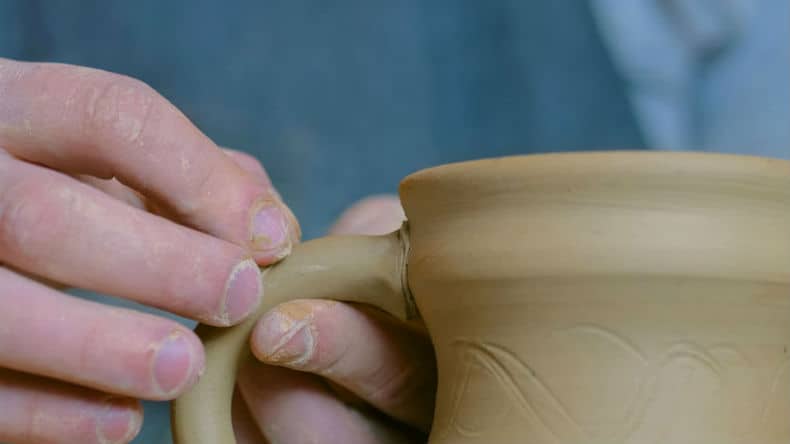
11) Consider the Clay That You lot are Using
Grog in clay reduces cracking during drying. Grog is clay that has been fired so footing upward into granules.
Clay with grog in information technology shrinks less because the fired clay that makes upward the grog has less h2o content. As such, dirt with grog contains less water and shrinks less.
Besides, the grog in the clay makes the clay particles less densely packed together. This means that water in the clay finds it easier to migrate to the surface and evaporate.
Because grogged dirt shrinks less, the pottery undergoes less stress during the drying process. As a result, it is less probable to crack.
Grog granules come in a range of sizes. Courser grog is tough on the hands if you are wheel throwing. Nonetheless, fine grog tin be added to clay and this is suitable for cycle thrown clay.
Final Thoughts
Many factors affect how dirt behaves. A few things might exist making your pottery clay crack. Information technology is possible that you may need to experiment a fiddling. However, if y'all use the guidelines above it will help you isolate why your clay is keen.
If you enjoyed this post, please share information technology!
References:
- https://world wide web.britannica.com/scientific discipline/kaolin
Source: https://thepotterywheel.com/why-pottery-clay-cracks/

0 Response to "How To Repair Crack In Clay Pot"
Post a Comment